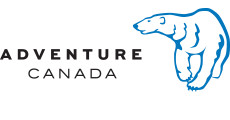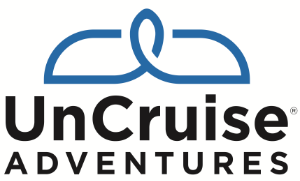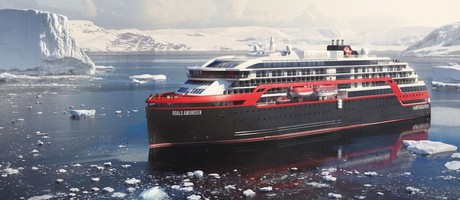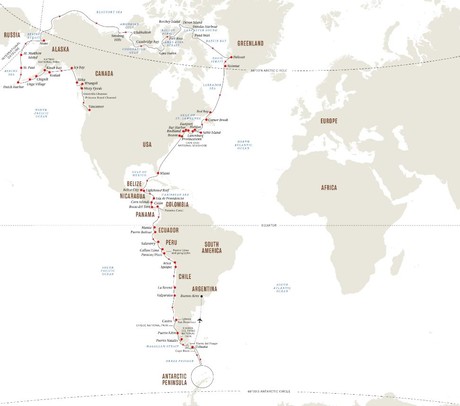Pole to Pole Adventure The Ultimate Bucket List Expedition Cruise
From Pole to Pole on an epic expedition of discovery This expedition cruise will be unlike any other cruise you’ve been on. We’ll begin our 94-day journey in Vancouver, Canada, sailing north along the Alaskan coast and crossing the Arctic Circle as we make our way through the fabled Northwest Passage to Greenland and Baffin Island. We’ll then turn south along the eastern seaboard of the United States to the warm and colourful tropical lands of Central America before passing through the Panama Canal and reaching South America. Here, we’ll experience a mix of culture and nature, exploring ancient sites in Ecuador, Peru, and Chile before witnessing the ethereal splendour of the Chilean fjords and Patagonia and – finally – the pristine otherworldly beauty of Antarctica. Culture, nature, and discovery On this grand expedition cruise, you’ll experience the amazing blend of culture and wildlife within the Americas and Antarctica. Your knowledgeable and passionate onboard Expedition Team will guide and inspire you throughout, ensuring your cruise will be as adventurous, educational and ecologically sustainable as possible.
Highlights
• Span the entire globe as we cruise from Pole to Pole - from the frozen north to the frozen south – discovering the cultures, ecology and wildlife of 11 countries over 94 days.
Your Pole-to-Pole expedition cruise begins in Vancouver. Set amidst beautiful mountain scenery and beside the waters of English Bay, Vancouver is both a bustling seaport and a cosmopolitan city. If you arrange to arrive a few days ahead of your cruise, you’ll soon find out just why people rave about British Colombia’s largest city. A centrally located hotel will be your base in Vancouver. Feel free to take it easy and enjoy the hotel’s amenities or lap up the city’s famed museums, galleries and nightlife. Vancouver’s various neighbourhoods buzz with world-class, farm-to-table cuisine. Chinatown and Punjabi Market have arguably the best Asian food in North America while Commercial Drive is the home of Little Italy. Don’t miss Vancouver’s oldest neighbourhood either. Gastown’s Victorian buildings house some of the hottest restaurants and its 167-metre-high Vancouver Lookout also offers a perfect panorama over the city. You can take in the neon lights and nightlife along the Granville Street strip or just go and chill on one of the beaches in West End. The latter is also the gateway to explore the wide-open spaces and towering red cedars of Stanley Park. Pre-Programme Why not pack some more experiences into your epic expedition cruise and book an optional Pre-Programme trip aboard the Rocky Mountaineer train taking you through the Canadian Rockies. The scenery is nothing short of spectacular.
After breakfast we’ll take you on a half day bus tour of Vancouver. Sit back, relax and enjoy the many sights of this beautiful and cosmopolitan city. Afterwards, MS Roald Amundsen, the world’s first hybrid-powered expedition ship, will be waiting for you at the pier. Once on board, you’ll meet the Expedition Team and crew members who will take you through a mandatory meeting related to health and safety – both yours and others. Once you get settled, you can familiarise yourself with this state-of-the-art vessel, specially designed with sustainable exploration in mind. After a welcome meal, your epic journey from pole to pole will be underway.
Sailing north, we make our way towards the narrow channels of Canada’s Inside Passage. You’ll feel the thrill of setting out on a great adventure as we navigate among the thousands of islands of the Pacific Northwest aboard the stylish and comfortable MS Roald Amundsen. Misty Fjords The first area you’ll explore is the spectacular Misty Fjords National Monument. Part of the two million acres of Tongass National Forest, this is a pristine coastal wilderness of evergreen trees, deep fjords and majestic snow-capped peaks. Wrangell, Alaska You’ll really feel like you’re stepping back in time at Wrangell, one of Alaska’s oldest and most historic island towns. Surrounded by the beautiful scenery at the mouth of Stikine River and beneath Mount Dewey, you’ll get back to nature on one of the local trails that takes you to the edge of the rainforest. Sitka Situated on Baranof Island on the outer coast of the Inside Passage, Sitka can only be reached by sea or by air. Tongass National Forest surrounds the town – the largest temperate rainforest in the world, and a local highlight is the 107-acre Sitka National Historic Park. With a history of settlement dating back over 10,000 years, Sitka is a place where ancient culture can still be felt. Tlingit traditions remain strong, existing side by side with Russian and American influences. Icy Bay The three prominent glaciers of Guyot, Yahtse, and Tyndall feed vast chunks of floating ice into the waters of the bay. Our aim will be to visit the 34-mile-long and 8-mile-wide Guyot Glacier, although this depends on local weather conditions. You’ll hopefully be able to go ashore as near to the glacier as is safe, or explore the waters in a kayak as part of an optional excursion. As ever, we’ll be on the lookout for all the awesome wildlife that abounds in the Gulf of Alaska, including humpback whales, orcas, Stellar sea lions, sea otters, harbour seals and more. Kodiak The bustling fishing port of Kodiak – Alaska’s largest – sits on the eastern shore of Kodiak Island, and the surrounding spruce forest and grassland here have inspired the nickname ‘Emerald Isle’. At 3,670 square miles and over 100 miles in length, this is the largest island in Alaska, and the second largest in the U.S. after Hawaii. The best-known park here is the Kodiak National Wildlife Refuge, covering two-thirds of the island. There’s a range of habitats here, from mountains to meadows, which are home to the island’s most famous residents, some 3,500 Kodiak brown bears. Katmai National Park Witness a park four million acres in size, with over a dozen active volcanos, and the location of the dramatic Valley of Ten Thousand Smokes. In 1912, this was the site of one of the most devastating volcanic eruptions ever recorded in modern times. We’ll spend the day cruising and looking for bears from deck or from our small expedition boats at one of three possible sites in the park, each of which are known for their communities of brown bears. In fact, Katmai National Park is synonymous with excellent bear watching, and has a population of protected grizzlies numbering more than 2,000. Chignik The small village of Chignik is a prime example of a typical Alaskan fishing settlement. Red salmon fishing has been the core of the community’s economy for over a century. Stop in for a look at the fish factory and meet the welcoming locals, or explore the salmon streams in the scenic surroundings. Around 20 waterfowl species inhabit the area, so see if you can see them, and be sure to look up to the skies to spot Bald Eagles. Unga Village Unga Village is a picturesque abandoned town on the southern end of uninhabited Unga Island in the remote Aleutian Islands. Settled by Aleuts in 1833, subsistence fishing proved insufficient to support the community, which had all but moved by 1969. Today, a collection of wooden buildings is all that remains, surrounded by a carpet of pink lousewort and fireweed flowers. Dutch Harbor The small town of Dutch Harbor is one of the most important fishing ports in the U.S., famous for appearing on the TV show The Deadliest Catch. Steeped in history, the port is home to the Museum of the Aleutians, the Aleutian World War II National Historic Area as well as the Russian Orthodox Cathedral, which dates back to 1896. Approximately 600 Bald Eagles along with some 40-50 million seabirds such as Puffins, Cormorants, and Kittiwakes inhabit the region around Dutch Harbor. St. Paul and St. Matthew Islands St. Paul Island is the largest of the Pribilof Islands, an important bird breeding area that’s also home to as many as 500,000 northern fur seals. You’ll pay a visit to deserted St. Matthew Island, said to be the most isolated place in Alaska. Nome You can see evidence of the Gold Rush era everywhere in the small town of Nome, including abandoned dredges, turn-of-the-century steam engines, and old railroad tracks. Cries of ‘Gold! Gold!’ might still be heard today by those prospecting along the banks of the Snake River.
We’ll sail through the Bering Strait and look to the skies to spot a range of seabirds. There are over 30 species here, including Black-legged Kittiwakes and various species of auklet and murrelet. Late summer sees upwards of 10 million winged wonders in the region, giving you plenty to point your binoculars at. Passing through the Bering Strait, we’ll have Russia to the west of us and the USA to the east. This is also the International Date Line, meaning we’ll have ‘tomorrow’ on our left and ‘today’ to the right. At this point we’ll also pass into the Arctic Circle. Crossing the Chukchi Sea, we’ll reach Point Barrow, the northernmost point of the U.S., and enter the Beaufort Sea. Keep an eye on the waters for bowhead and grey whales which can be spotted here, and we might also start seeing sea ice from here on.
Continuing into the Amundsen Gulf, we’ll hope to observe the remarkably colourful Smoking Hills – an amazing sight. Smoke billows from the cliffs on the east coast of Cape Bathurst due to lignite – a combination of eroded shale and pyrite – spontaneously igniting when it is exposed to air, creating this unusual and photogenic phenomenon. Roald Amundsen – after whom our ship is named – was the first to conquer the Northwest Passage on an expedition that lasted from 1903 to 1906. Before him, many others had tried without success, with the earliest known attempt being as far back as 1497. In the modern era, aboard our state-of-the-art expedition ship, we’ll also enter the Northwest Passage on our own adventure, setting a course for Greenland and eastern Canada. During our passage, we’ll land at sites linked to early explorer history, visit Inuit communities, and attempt to spot Arctic wildlife such as polar bears, whales, seals, and a variety of seabirds. There may also be opportunities for small boat cruising between ice floes, and in true expedition style we’ll head ashore and experience the pristine wilderness of the Canadian Arctic. The ship’s Captain and Expedition Team leader will continuously assess the current weather and sea conditions, adapting activities accordingly, and adjusting the itinerary to take account of the sea ice. Like all good explorers, we must respect and work with nature, not against her. Here are some of the places in this wild and untamed region that we hope to explore together during landings and short walks, if wind, waves, and sea ice allow: Ulukhaktok Many in the 500-strong community here are involved in the local artists' co-op, producing prints, tapestries, and other crafts. This is also the location of the world's northernmost golf course which plays host to a tournament each summer. Cambridge Bay Located on Victoria Island, this is a common stop for vessels traversing the Northwest Passage. It’s also called ‘Iqaluktuuttiaq', or ‘A Good Fishing Place’ due to the Ekalluk River which attracts Arctic charr, a type of coldwater salmon. Gjøa Haven Roald Amundsen wintered at this hamlet in 1903. During his time here, he learnt crucial survival skills from the local Nesilik people. This knowledge would later give him the upper hand in his famous race to the South Pole in 1911. There is an informative walking tour and a Heritage Centre dedicated to the history and culture of the area. Fort Ross Here we’ll investigate an abandoned Hudson’s Bay trading post located at the southern end of Somerset Island. The storehouse here is still used as a shelter by occasional travellers, with bunk beds and shelves of canned goods. Beechey Island This is the final resting place for three members of the infamous Franklin expedition which sailed into the Northwest Passage in 1845 but never returned. It is customary for explorers in the region to stop and pay their respects at the graves, as Roald Amundsen did in 1903. Devon Island Welcome to the largest uninhabited island on Earth. The only signs of human life here are found at the long-abandoned settlement of Dundas Harbour, along with several archaeological sites from the Thule period. Pond Inlet Called 'Mittimatalik' in Inuktitut, it means ‘The Place of the Landing Place’. This is a traditional Inuit community on Baffin Island, with incredible views of the Eclipse Sound and the mountains of Bylot Island. It’s also known as a great place to see narwhal - the so-called ‘unicorn of the sea’.
As we emerge from the Northwest Passage, we leave Canadian territory behind us for now and set our course for Greenland. While sailing across Baffin Bay and the Davis Strait, you’ll continue to enjoy informative lectures in the Science Center. Some of the topics may include wildlife you might see, Greenlandic culture, expedition history, geology, photography, and lectures on historic explorers. Ilulissat, Greenland Translated simply as ‘Icebergs’, Ilulissat is set in the stunning scenery of the Ilulissat Icefjord, a UNESCO World Heritage Site. This place is truly picture perfect. It’s also a vibrant hub for adventure seekers who head out onto the polar ice sheet, and there are almost as many sled dogs living here as there are people. Just outside the town, you can often see enormous icebergs floating in the deep blue waters. They originate from the Jakobshavn Glacier, which calves some 35 billion tons of icebergs each year. These bergs make their way down the 12-mile fjord before entering Disko Bay – and with their shimmering forms and delicate hues they’re a nature photographer’s dream. Sisimiut, Greenland Greenland’s second-largest settlement sits 25 miles north of the Arctic Circle in the central coastal area of the Davis Strait. Its name translates into ‘The People at the Fox Holes’, a reference to the many Arctic fox burrows found nearby. Another local animal is the musk ox, whose wool is used to make a special fabric called qiviut—said to be 10 times warmer than sheep wool. After Sisimiut we’ll set out across the Labrador Sea, and you’ll have time to relax, get to know your fellow travellers better, and make full use of the facilities on board. In the Science Center the Expedition Team will continue to give fascinating lectures about the wildlife and ecosystems of the Arctic region. Red Bay, Canada Red Bay is a former Basque whaling settlement on the coast of southern Labrador in the Strait of Belle Isle. You might catch sight of humpback or minke whales as we sail these waters. Not all the whaling vessels were lucky enough to reach Red Bay’s shores, and wrecked galleons and chalupas – small boats used by whalers in the 16th Century – are just some of the ships that have been found preserved in these icy waters. The discoveries make Red Bay one of the most important underwater archaeological sites in the world. Corner Brook, Canada As we sail into the Bay of Islands, surrounded by the jagged slopes and dense forests of the Long Range Mountains, we’ll be charting the same course taken by Captain James Cook over 250 years ago. Just like the famed British explorer, we’ll head to Corner Brook at the mouth of the Humber River. This is the second-largest city in the Newfoundland and Labrador province after St. John’s. If the latter is trendy and international, Corner Brook is decidedly traditional and local.
The next leg of your journey begins in Halifax, the cosmopolitan capital of the Canadian province of Nova Scotia. This well-situated seaport looks out over one of the world's largest natural harbours. Sable Island, Canada Our first stop after Halifax is the long, crescent-shaped Sable Island, some 185 miles to the east. The name comes from the French word for sand, and this unusual sandbar island cannot support any natural trees. People come here to see the wild horses, over 550 of which are thought to live here. Due to frequent heavy fog and strong currents, even our modern navigation equipment can struggle with the unpredictable waters close to the island, making landing a challenge. Should the weather choose not to cooperate, the Captain will manoeuvre close enough to see the horses from the observation deck. If conditions are more favourable and we are able to go ashore, we’ll see the Sable Island horses at close range, and will also be on the lookout for harbour and grey seals on the shore. Lunenburg, Nova Scotia Seeing the colourful buildings along the waterfront will mark your first sighting of Lunenburg, a UNESCO World Heritage Site. Its brightly painted houses and square gardens are almost unchanged since the 1700s, when it was a British colonial settlement. Eastport, Maine As we pass from Canadian waters into the U.S., the next stop on our expedition cruise is Eastport City on Moose Island. Archaeologists believe the native Passamaquoddy lived here for at least 10,000 years before the first Europeans appeared in 1604. While we’re in Passamaquoddy Bay, you may want to go and see Old Sow – a whirlpool believed to be the biggest in the western hemisphere and so-named for the ‘squealing’ noise it is said to make as it spins. Rockland & Castine, Maine If you’ve ever been served a Maine lobster, chances are it passed through Rockland. Art lovers should check out the Center for Maine Contemporary Art and the Farnsworth Art Museum, which contain works by Andrew Wyeth and other New England painters. When night falls here, something magical happens. We’ll drop anchor in Castine Harbor, where the unique aquatic ecosystem creates the perfect environment for bioluminescent phytoplankton to thrive. Subject to availability, we have a number of kayaks so you can get up close to see this natural phenomenon, gliding between the starlit sky and the shimmering waters. Bar Harbor, Maine Perched in Frenchman’s Bay on Mount Desert Island, Bar Harbor sits at the entrance to Acadia National Park and provides views over Cadillac Mountain and the Cranberry Islands. Its seafood restaurants are said to be among the finest in New England! Provincetown, Massachusetts Provincetown is something of an artistic hub. Painters such as Jackson Pollock and Hans Hofman have been drawn here since the 1940s. The Cape Cod National Seashore protected dunes are within walking distance of the town, and you can explore them on foot or as a possible excursion by dune buggy. For whale watching opportunities, the offshore Stellwagen Bank National Marine Sanctuary attracts 17 species of cetaceans, so make sure you bring your binoculars. Boston, Massachusetts Home to Harvard and the Red Sox, there’s something for everyone to love about Boston. It’s one of the most European-looking American cities, and it’s packed with history. With cobbled streets, Tea Party attractions, and the fascinating Freedom Trail, it’s the perfect place to explore on foot.
With several days at sea, enjoy the onboard facilities such as the infinity pool, hot tubs, sauna, indoor gym, outdoor running track, and spa. Feel free to indulge yourself with a treatment in our Wellness Center, or take part in an art workshop. Eat in style in one of our three restaurants and spend time out on deck looking for seabirds and other marine wildlife. You'll also use these days at sea to better get to know the Expedition Team, who’ll be like friends by now. They’ll continue to deliver in-depth lectures on a wide range of subjects relating to the up-and-coming destinations. Or, if you haven’t already done so by now, why not throw yourself into one of our Citizen Science projects. These gather real data and are aimed at helping scientists better understand the environment in order to help combat many of the problems that threaten our planet.
Miami, Florida The reputation of the ‘City of Neon’ as one of the world's most popular vacation destinations is well earned, and you’ll see why. Year-round sunshine? Check. White-sand beaches? Yes. Clear teal waters? Yep. These are just a few reasons why visitors come here in droves. And while there’s all the glitz you’ve seen in the movies, there’s a lot more to Miami than cocktails and luxury yachts. Delve a little deeper and you’ll find a thriving metropolis with vibrant doses of Latin American, Caribbean, Asian and European influence. Belize City, Belize Charming, low-rise Belize City is a laid-back Caribbean coastal gem. Here you’ll find colourful British colonial architecture and monuments, a reminder of the city’s past as the country’s former capital. Our main focus for the day lies 31 miles north of the city at the well-preserved Mayan ruins of Altun Ha. The evocative site is hemmed in by wildlife-rich jungle, and features two main plazas surrounded by numerous ancient temples and pyramids. Lighthouse Reef, Belize Belize’s famed barrier reef is one of the country’s main attractions, and it’s considered to be one of the best marine sites in the entire Caribbean. It hosts an extraordinary variety of sea life, lush keys, and opportunities to get active. We anchor for the day at the uninhabited Half Moon Caye island in the Lighthouse Reef, the most remote of the atolls. This island is best known for the sanctuary it provides to the rare Red-footed Booby. Isla de Providencia, Colombia This remote mountainous island in the Caribbean was once used as a base by 17th Century Pirate Henry Morgan to plunder passing imperial galleons loaded with gold doubloons. Legend has it that much of the gold remains hidden on the island, but perhaps the real treasures are gorgeous sandy beaches, friendly locals and pristine waters. Sadly, the island was hit by Hurricane Iona in 2020. Rebuilding works are underway and our visits are vitally important in helping local businesses and the community as a whole to recover. Corn Islands, Nicaragua One of the best things about our expedition cruises is our ability to bring you to smaller, hard-to-reach destinations that are often missed by the bigger cruise ships. We plan to land on Big Corn Island, situated roughly 50 miles off the coast of Nicaragua. You’ll find none of the usual tourist traps here, just a slow island vibe with beautiful beaches and genuinely friendly people. You’ll get the feeling this is a place where everybody knows everyone, and you’ll be welcome wherever you go. Feast on some juicy lobster and then swing in a beach hammock as you feel the tropical island bliss wash over you. Bocas del Toro, Panama Bocas del Toro is a dreamy tropical archipelago made up of nine main islands and hundreds of smaller ones. This is what people imagine when they dream of paradise. Now a UNESCO World Heritage Site, this National Marine Park is one of the most biologically diverse places on Earth, and its many islands support an exotic mix of wildlife, including sloths, red frogs and leaf-cutter ants. We’ll hop onto a local water taxi transport to one of the surrounding islands and go on a guided walk. One place we might visit is Red Frog Beach where you can try and spot the eponymous frogs. Or maybe we'll venture to Solarte Island, which has a number of great hiking trails for nature walks. Colón This bustling Caribbean seaport is a popular stop for ships preparing to transit the Panama Canal, and has a diverse population for such a small size. As you might expect, there are loads of great restaurants here, as well as numerous opportunities for buying things.
Panama Canal We’ll pass through the Panama Canal, a 50-mile-long man-made marvel of engineering featuring channels and open water that was opened to traffic in 1914. The canal links the Atlantic to the Pacific, and roughly half way through the 12-hour transit we’ll enter the Gatun Lake section. If you’re lucky, you may spot a crocodile or alligator on the shore. Watch the trees and you may also catch a glimpse of monkeys, and maybe even a sloth or two. Manta, Ecuador MS Roald Amundsen will bring us across the Equator early in the morning, and you can join a traditional ceremony on board in which we seek King Neptune’s blessing. Setting foot on South American soil, our first port of call is Montecristi, located five miles inland from the tuna-fishing port city of Manta. This town was established in the 16th Century by Manteños – indigenous Ecuadoreans – seeking respite from the frequent pirate raids on the coast. Montecristi, is actually the birthplace of traditional Panama hats, despite the name. Puerto Bolivar (Machala), Ecuador Machala’s main claim to fame is Puerto Bolivar, an important port for the export of coffee, cocoa, shrimp and bananas, which the locals call oro verde – ‘green gold’ – due to there being so many of them growing in this region. The nearby Puyango Petrified Forest has one of the largest collections of fossilized trees in the world, thought to be about 100 million years old. Salaverry, Peru Buffeted by the Pacific’s wind and waves, Salaverry can be a tricky port to access. If we are able to land there, it’ll be a good starting point to explore Trujillo, Peru’s third-largest city, as well as the array of pre-Colombian archaeological sites scattered throughout the region. Lima, Peru Set on a strip of desert between the Pacific Ocean and the Andes mountains is the Peruvian capital Lima. Served by the seaport of Callao, Lima is the largest city in the country and appears as a modern, sprawling metropolis where traditions and modernity swirl together to create a heady cocktail of culture and cuisine. In contrast to this modern metropolis, the fascinating and enigmatic adobe clay ruins of the Huaca Pucllana and Huaca Huallamarca ceremonial pyramids are all that remains of a long-lost ancient culture. Paracas, Peru Nestled on a bay behind a peninsula, the humble and sleepy resort town of Paracas is surrounded by brown-coloured cliffs and lovely beaches. Opposite Paracas harbour is a mysterious local geoglyph carved into the landscape of a candelabra-like symbol, the origin and meaning of which remains a mystery. It could be related to the famous Nazca Lines which you can visit in the Pisco Valley a short drive away to the south as part of an optional excursion. Arica, Chile Unusual for a city by the sea, Arica is bathed in glorious sunshine almost every day of the year and residents proudly describe the place as being immersed in a never-ending spring. Check out the eye-popping San Marcos Cathedral, designed by Gustave Eiffel of Parisian tower fame, and inaugurated in 1876. Iquique, Chile Welcome to a slice of paradise by the Pacific, complete with palm trees and beach promenades. Our main plan here is a visit to the nearby abandoned saltpetre mining town of Humberstone in the Atacama Desert, an UNESCO site, and a piece of history you can literally walk through. La Serena, Chile Sat beside the ocean, La Serena is blessed with beautiful sandy beaches all along Avenida del Mar and beyond. You’ll find that Chile’s second-oldest city has a distinct neo-colonial look and feel to it. Modern buildings sit interspersed with classic architecture, such as the 30 or so carefully restored stone churches, some of which are around 350 years old. Valparaiso, Chile Known as UNESCO's ‘Jewel of the Pacific’, this World Heritage listed city is a maze of monuments, churches, historical funicular cable cars, trendy neighbourhoods, cobblestone alleys, colourful houses, and charming plazas.
Castro We have made it as far as Patagonia. In Castro, bring your camera to snap the brightly painted palafitos. These are the traditional wooden stilt houses lining the edge of the fjord at Gamboa Wharf. The nearby UNESCO-listed Church of San Francisco is a masterpiece of carpentry made entirely of wood in the neo-Gothic style. Puerto Eden The tiny hamlet of Puerto Eden sits on a bay and is part of a remote peninsula that juts out into a fjord in the province of Última Esperanza – meaning ‘Last Hope’. From here there’s access to the exceptional landscapes of Bernardo O'Higgins National Park – Chile’s largest protected area, comprising a stunning network of peaceful fjords and gorgeous forest-mantled mountains. There are no roads to, from or even within this isolated village, just boardwalks and footpaths that connect the homes of its less-than 200 inhabitants. Puerto Natales Take in the breathtaking views of the southern Andes as we arrive at Puerto Natales. The city is an entry point to Torres del Paine National Park, which attracts hikers and climbers from all over the world. Aside from a full-day optional excursion to the national park, you can also spend some time leisurely exploring Puerto Natales on foot. This sleepy city is a mix of Bohemian bars, shops selling outdoor gear, corrugated tin houses, and eateries serving up global cuisine. Chilean fjords We’ll cruise amongst the fabled fjords and multitude of islands found within Chile’s rugged Magallanes Province, where jagged mountains reach for the sky. Then we’ll pass through the western part of the Strait of Magellan, named after the famous 16th Century Portuguese explorer who first traversed it. The scenery is so fantastic here you’ll feel an innate sense of wonder and peace! Cape Horn & the Drake Passage After looping round the glacier-carved Alberto de Agostini National Park, we enter the Beagle Channel. Take in the stunning landscapes as we pass between the national park and Isla Gordon, part of the Tierra del Fuego archipelago. At the tip of South America lies legendary Cape Horn, a major milestone in the old clipper routes that connected Europe with the Far East and Oceania. This is where the open waters of the Atlantic and Pacific collide, creating powerful waves that are further strengthened by swirling westerly winds. For yachters, rounding Cape Horn is a maritime feat akin to summiting Mount Everest. Given the notoriety of these turbulent waters, we can’t guarantee a landing, but if fortune favours us on the day with weather stable enough to set foot on the island, you’ll be among a select few people in the world able to boast about it. From Cape Horn, it’s a clear shot to Antarctica across the Drake Passage.
Nowhere else on Earth can we find anywhere that compares to this otherworldly landscape of snow and ice. The wind and waves mix with the late spring sun to sculpt icebergs into massive white and blue gems, some as tall as buildings. Immense ice shelves and crumpled glaciers creak and rumble while chunks of ice crash into the waters below. Mighty mountains hibernate beneath blankets of soft snow. Welcome to the unmatched Seventh Continent. Welcome to Antarctica. You’ll be spending the next four days exploring several of more than 20 possible landing sites on and around the Antarctic Peninsula and South Shetland Islands. Wherever we go and whatever we do, each day in this immense and pristine region will offer you something different and thrilling. We might spend our time sailing into a flooded volcanic caldera or landing at dramatic bays that still harbour relics from the whaling era. And you’ll go ashore and stand in the presence of thousands of penguins – of course, keeping a good distance away from any inquisitive ones who come to inspect you. This being the Antarctic late spring, Gentoo and Chinstrap Penguins will be at the start of their courting season, while the more advanced Adélie Penguins may have already laid their eggs and could be nesting. There are many other birds in Antarctica to see, including Skuas, Jaegers, Petrels and Terns. Unlike penguins, these birds can actually fly, so remember to point your binoculars up to the sky now and again. The Expedition Team will be with you each step of the way, guiding you on landings and leading ice-cruises aboard small expedition boats. Depending on the local snow, ice and wind conditions, you might be among the fortunate few to join optional activities like kayaking and snowshoeing, or even spending a night camping on land. There will also be easy-to-do Citizen Science projects like cloud observation, whale and leopard seal spotting, and analysing phytoplankton under the microscopes in the Science Center. It is satisfying to know that the data you help collect as part of these projects feed into real scientific studies at key institutes around the world. The resident photographer will also have some handy tips for you on how you can best capture the stunning landscapes and photogenic wildlife. Don’t forget to come out from behind your lens now and then though, just to take it all in!
After the magic of Antarctica, we have a two-day journey back across the Drake Passage to South America. It’s the perfect time to wind down and reflect on your experiences in the frozen continent. Pamper yourself in the Wellness Center with a soothing treatment, and hang out in the Explorer Bar with your new-found-friends chatting about your shared memories from the trip. Your photographs are like trophies, so display them proudly and swap stories about your different adventures and experiences. And why not join the Expedition Team in the Science Center to take a look back at everything you’ve seen and learned along the way. Your Pole-to-Pole journey has now come to an end. Once we arrive in Ushuaia, Argentina, there’ll be a transfer to the airport for your flight to Buenos Aires. It’s up to you whether you fly home directly or spend a few extra days exploring the birthplace of the tango. Before you disembark, it will be time for a bittersweet goodbye to the ship, the crew, your fellow guests, and the amazing Expedition Team. Each of them has worked very hard to make your adventure a joyful and unforgettable one. We share an overall goal: to show that expedition cruises can and should be as sustainable as possible, and to inspire all of us to do more to protect and cherish the delicate balance of life on our planet. This is the appreciation we want you to take home with you and share with your friends and family. Here’s to seeing you on your next adventure! Post-Programme Perhaps you’re not quite ready for your adventure to end just yet. Seeing as you’re in the area, why not add on a Post-Programme to see the magnificent Iguazú Falls on the Brazilian border. You’ll visit Iguazu´s cascades and viewpoints, seeing them from the Argentinian and Brazilian side. The trip includes a scenic train ride to the upper falls.
Itineraries are subject to change.
|
Book now |
Polar Outside. From
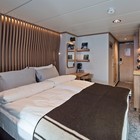
Arctic Superior. From
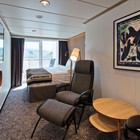
Expedition Suite. From
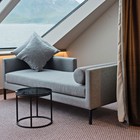
96 Day Voyage - Montreal to Buenos Aires
Vessel Type: Expedition Ship
Length: 140 metres
Passenger Capacity: 530
Built: 2019
In 2019, Hurtigruten adds a brand new ship to its fleet: the MS Roald Amundsen. The state of the art vessel features new and environmentally sustainable hybrid technology that will reduce fuel consumption and show the world that hybrid propulsion on large ships is possible.
MS Roald Amundsen is the first of two hybrid ships Hurtigruten will add to its fleet over the next few years, cutting emissions by sailing with electrical propulsion. Hybrid technology, combined with the advanced construction of the hull and effective use of electricity on board will reduce fuel consumption and CO2-emissions on the ships by 20 percent. The build of these two ships represents the largest single investment in the history of Hurtigruten.
The future of shipping will be silent and emission free. MS Roald Amundsen will lead the way towards an even more sustainable way of traveling. Sailing on electrical power is not only a great benefit for the environment, but it will also enhance the impact of experiencing nature for the guests. The ship will be specially constructed for voyages in polar waters and serve as a comfortable basecamp at sea – bringing adventurers from all over the world to the most spectacular destinations in the most sustainable way.
Facilities on board
One of the most eye-catching exterior design features of the ships will be the two-level indoor/outdoor Observation Deck wrapped around the top of the ships’ raked bow. In a vast area behind it, you’ll find the core of the onboard experience: Amundsen Science Center.
Packed with state of the art technology and high tech gadgets such as touch screens and science equipment, the immersive edutainment area will be the place guests and staff/crew meet, mingle and create a deeper understanding for the areas they explore. The flexible venue will feature lecture spaces, a small library, and speciality areas for workshops in photography, biology, and more. The area, featuring large windows, will also be the onboard HQ for Hurtigruten’s hand picked Expedition Team.
The stunning scenery will be reflected in a rich and comfortable interior design. Scandinavian materials from nature, such as granite, oak, birch and wool will be used to create relaxed and stylish cabins and public areas. All cabins are outside, 50 % will have private balconies, aft suites will feature private outdoor Jacuzzis with spectacular views.
MS Roald Amundsen will feature three restaurants inspired by Nordic and Norwegian heritage:
Aune Main Dining, named after the Norwegian ship chandler and polar expedition supplier Tinus Aune.
Fredheim - the ships’ informal and social meeting place – named after a 1900s hunting station on Svalbard.
Lindstrøm, a speciality restaurant named after Adolf Lindstrøm, the favorite chef of the Norwegian polar heroes.
Artwork on board
When the world’s first hybrid powered expedition ship embarks on her maiden voyage, every piece of art on board will be handpicked by HM Queen Sonja of Norway’s art foundation - the Queen Sonja Print Award. Read more about the exciting collaboration here.


Optional Tours & Excursions Available. Please Contact Us for More Details.
Inclusions
HX Expedition voyages include
• Voyage on board in selected cabin category
• On board lectures
• Daily expeditions and activities such as hikes, community visits, talks and more
• Full board dining, including breakfast, lunch and dinner with house wine and beer
• Wine, beer, spirits and cocktails available across the day and evening
• All-day coffee, tea & soft drinks
• Free Wi-Fi
• Gratuities
• Our interactive science programme, Science Centre and activities both on and off the ships
• Access to sauna, hot tubs, fitness room and more
• Professional photos from the onboard photographer
• Opportunities to engage with and support local communities and environmental initiatives through Hurtigruten
Foundation.
• Take home expedition jacket and reusable water bottle
• Expedition photographers on hand to assist you
Coastal Voyages include
• Full board (breakfast, lunch, and dinner) from Norway's Coastal Kitchen
• Norwegian- and English-speaking Coastal Experience Team on board
• Engaging onboard activities and lectures:
• Onboard lectures and presentations on Norway’s history, biology, geography, geology, and culture
• Introductory photo presentation, camera adjustment and tips and tricks, photo and film footage from the voyage
• A welcome event, and daily gatherings to recap the day and prepare for the day to come
• Presentations about the ports we visit
• Presentation of excursion programmes
• Point of interest presentations out on deck
• Captain’s dinner and a farewell event
• Hotel
• Hotel overnight in Vancouver, incl. Breakfast
• Flight
• Flight in economy class between Ushuaia and Buenos Aires
• Transfer
• City Tour in Vancouver, incl. Lunch box, ending at pier
• Transfer between ship and Ushuaia airport
Exclusions
• International and domestic flights unless otherwise stated
• Passport and visa costs where applicable
• Travel insurance
• Transfers unless otherwise stated
• Optional Excursions
• Pre and Post voyage accommodation
• Beverages on board unless otherwise stated (Premium drinks (top shelf spirits, vintage wines, champagne, etc.)
• Meals while ashore
• Optional treatments in the onboard wellness and spa area
• Some specialist excursions and experiences with limited capacity
• Fine dining in our Lindstrøm restaurant
• For those who want to set sail in style for a little bit extra, our Expedition Suites offer a complimentary bottle of champagne, unlimited access to our Lindstrøm fine dining restaurant, laundry and turn-down service and more.
Notes
• All planned activities are subject to weather conditions
• Excursions and activities are subject to change
• Please make sure you meet your entry and boarding requirements
Our Associates Include
